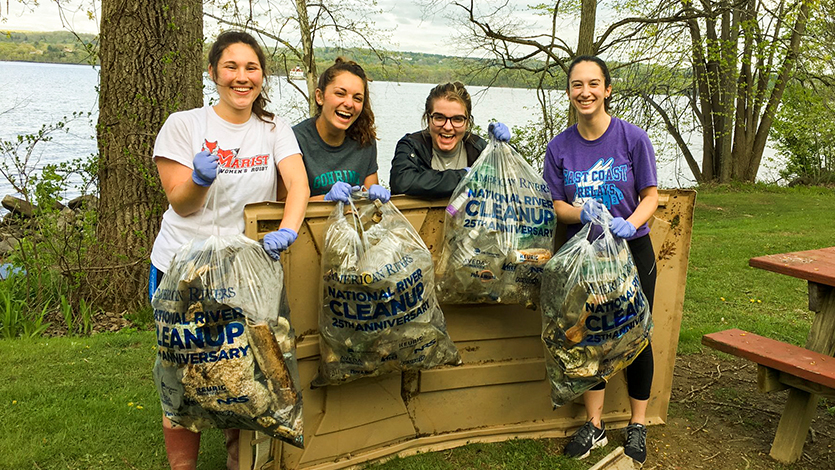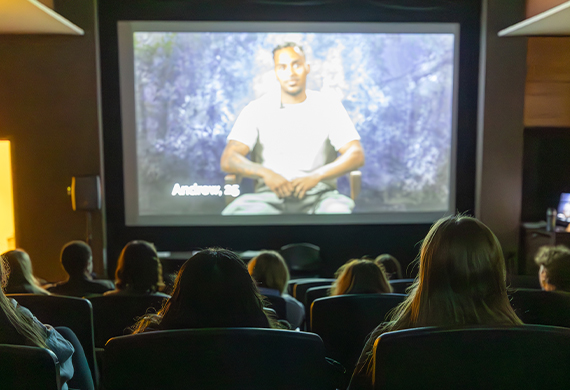Doing Research, Doing Good
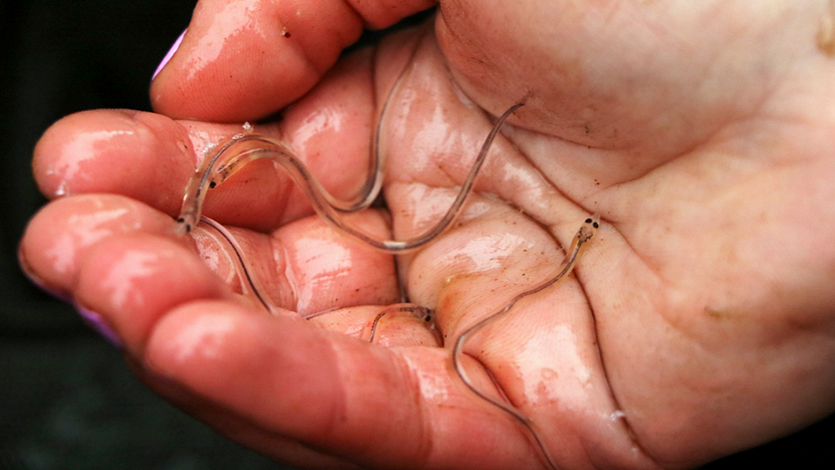
Studying American eels in the Hudson River
July 16, 2019—Chris Bowser is the Education Coordinator for New York State Department of Environmental Conservation (NYSDEC) Hudson River Estuary Program and the Hudson River National Estuarine Research Reserve, but he is also a longtime instructor in Marist’s Department of Environmental Science and Policy. And he has found a way to blend those two worlds in a way that benefits both Marist students and the local environment. For more than 10 years, Bowser has been leading science students in the study of migratory eels in the Hudson River. The semester-long research project is a collaboration between scientists, local residents, high school students, and students from the College, and it recently expanded to include research on changes in eel pigmentation.
The American eel is born in the Atlantic Ocean and enters North American tributaries as tiny “glass eels” each spring. Unfortunately, the species has declined over much of its range, and baseline studies are needed for further management. In New York, a project to study the eel is coordinated by NYSDEC in partnership with Cornell University’s Water Resources Institute; it takes place at multiple sites from Staten Island to Albany. As part of the project, teams of scientists, students, and community members collect glass eels using specialized nets and traps on Hudson River tributaries each spring. The juvenile fish are counted, weighed, and released, and other environmental data is recorded. At the end of each season, the data is compiled and sent to governmental decision-makers.
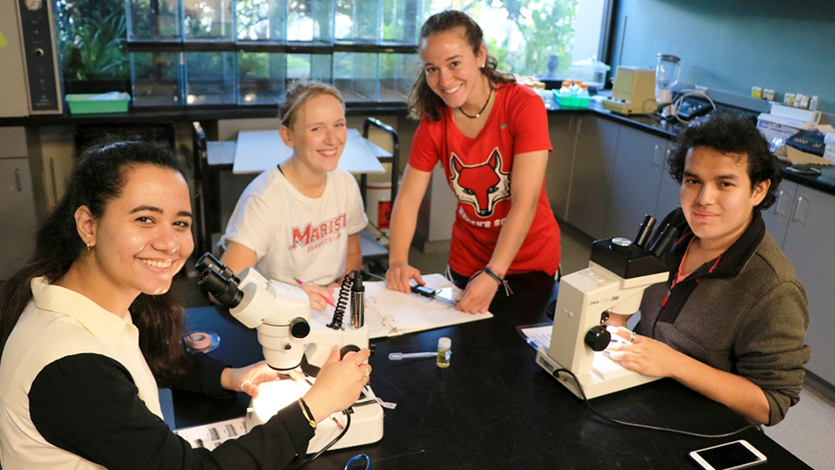
Bowser notes that the eel project is a win-win situation, with participants gaining academic credit and hands-on research experience while also doing their part to help the environment: “The project directly involves Marist students with scientific design and field methodology. And students experience the local ecosystem firsthand while collecting important information and relevant data about migrating fish.” This past spring at the Fall Kill in Poughkeepsie, the Marist interns caught, counted, and released migrating juvenile American eels every day for two months. There they not only conducted field work but also worked alongside Poughkeepsie High School students performing after-school volunteer work. Adds Bowser, “This program is a really great example of community science in action. It is helping New York State collect important data and putting conservation in the hands of local students.”
This year, Marist students also had the opportunity to conduct a related scientific study. Specifically, the students set out to examine changes in glass eel weight, length, and pigmentation throughout the season. Twice a week, the team collected 20 glass eels from NYSDEC sampling nets, brought them back to the lab at Marist, and carefully measured their weights, lengths, and levels of pigmentation. Their study offers clues about how and when eels develop within the estuary, as well as providing information of interest to the Atlantic States Marine Fisheries Commission, an interstate body that coordinates the conservation and management of 27 nearshore fish species. The Marist students who conducted the specialized research were Rodina Abdelhady ’21, a biomedical sciences major from Wappingers Falls, New York; and environmental science and policy majors Jeramie Glynn ’20 of Summit, Pennsylvania; Kathryn Samarro ’21 of Wyckoff, New Jersey; Bridget Connolly ’20 of Rumson, New Jersey; and Clairice Drexler ’20 of Southington, Connecticut.
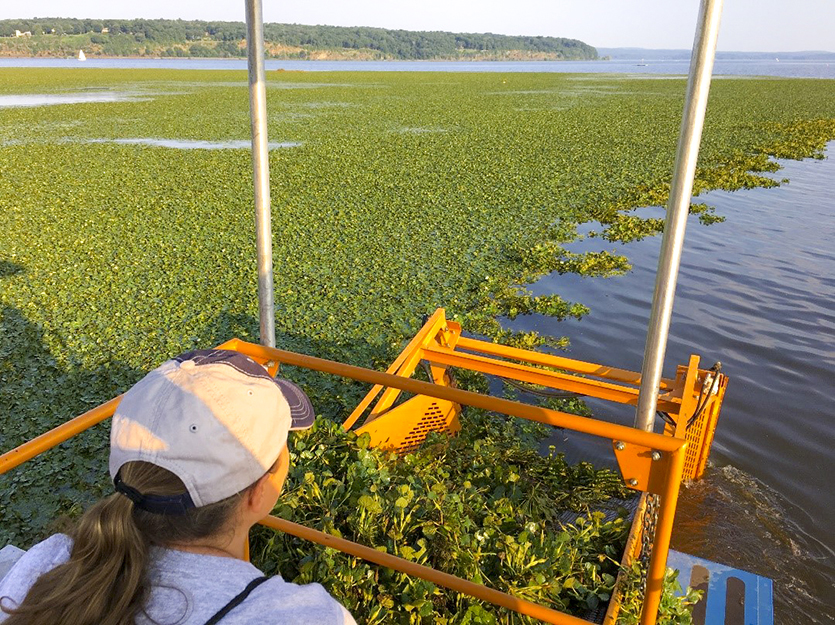
Keeping the Hudson River Valley clean and beautiful
Senior Lecturer of Biology Amy Cahill has also gotten Marist students involved in protecting the local environment. Most recently, they volunteered to support the efforts of Riverkeeper, a community organization dedicated to protecting the environmental, recreational, and commercial integrity of the Hudson River and its tributaries. On May 4, Cahill led 13 Marist students in the 8th Annual Riverkeeper Sweep cleanup event in Esopus. The students picked up 139 plastic bottles, 141 bottle caps, and more than 300 pieces of foam, glass, and plastic. Says Cahill, “This was my fifth year involving students as co-leaders/volunteers at this event to clean up parks along the Hudson River. A really nice aspect of this project is that our students worked side by side with residents of the local community. And for the past two years, we’ve recorded data on what we collect for a wider study with Riverkeeper.”
Earlier in the 2018-19 academic year, Cahill spearheaded another project in which Marist students volunteered to remove water chestnuts from the Hudson River. Along with Cahill, biomedical sciences majors Meaghan Ranalli ’22 of Fishkill, New York and Ovie Obaro ’19 of Kingston, New York manned a water chestnut harvesting boat to assist with the management of this invasive species. Water chestnuts are a significant environmental nuisance because they form nearly impenetrable floating mats of vegetation. The mats are hazardous for boaters and can severely limit light penetration into the water and negatively impact the growth of native aquatic plants beneath the canopy. The reduced plant growth, combined with the decomposition of the water chestnut plants, can result in reduced levels of dissolved oxygen in the water, impact other aquatic organisms, and potentially lead to fish kills. Looking ahead, Cahill has been granted a sabbatical for the spring 2020 semester, and she plans to involve Marist students in a study of invasive species management strategies in the Hudson Valley.
